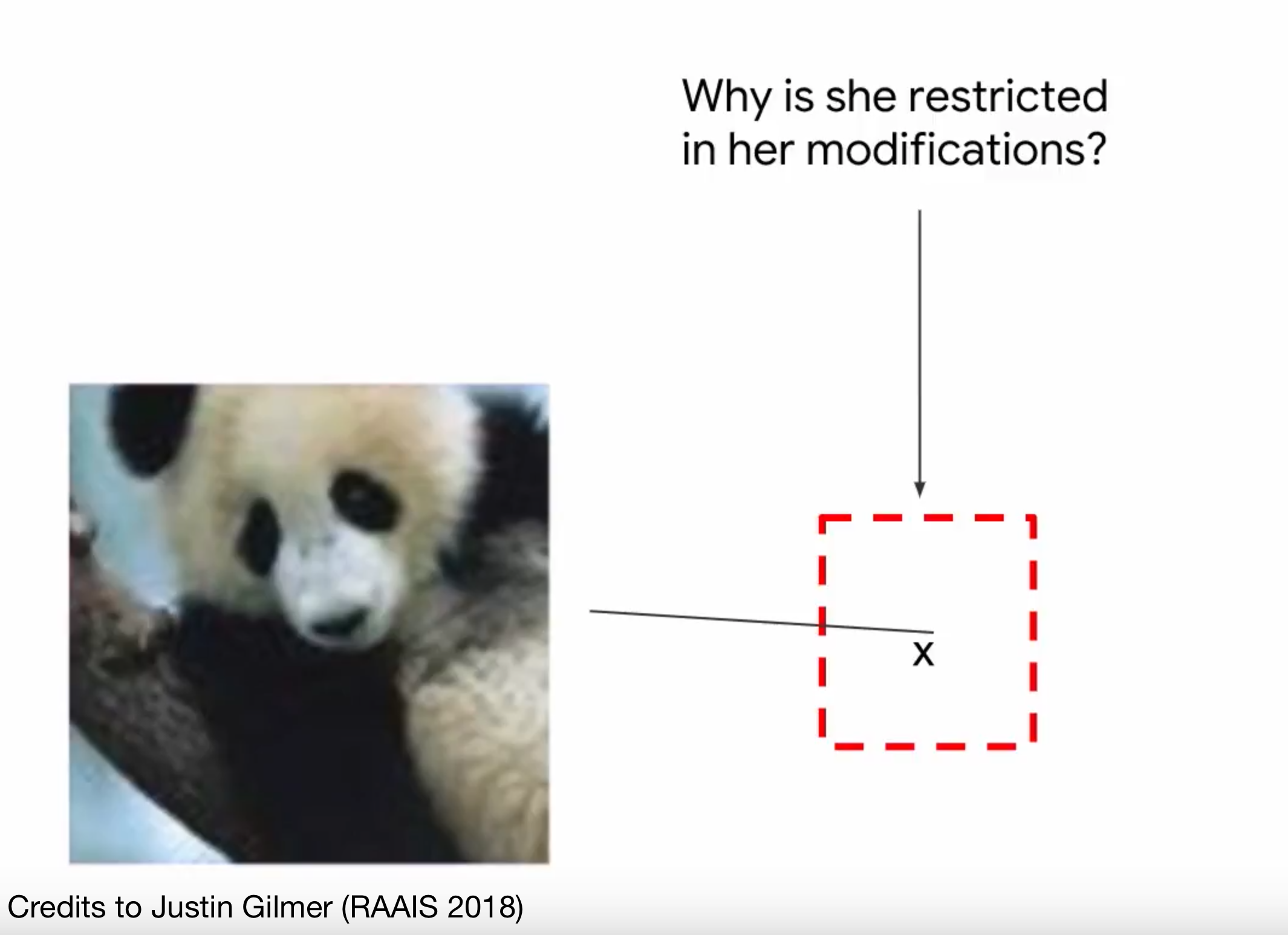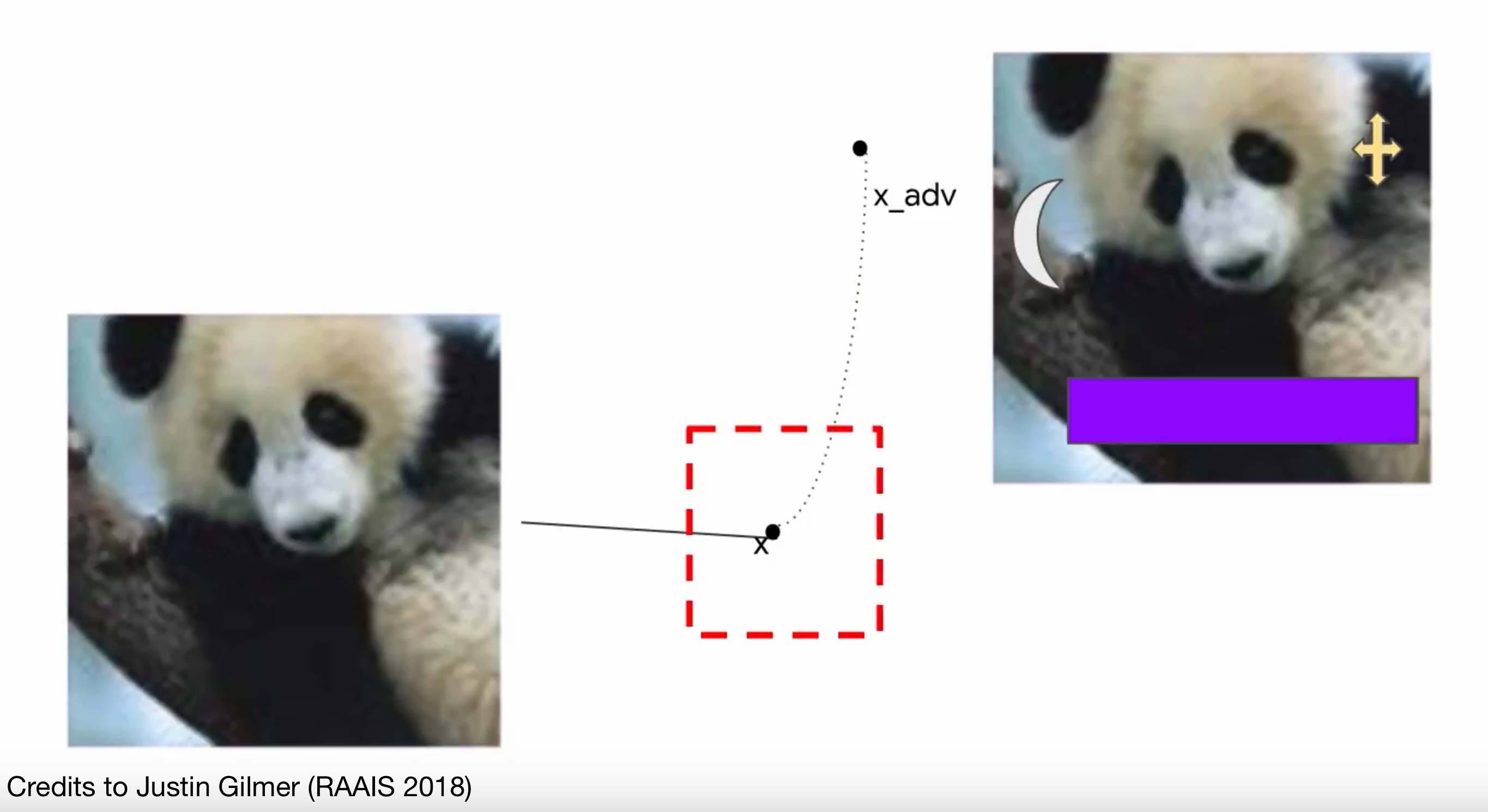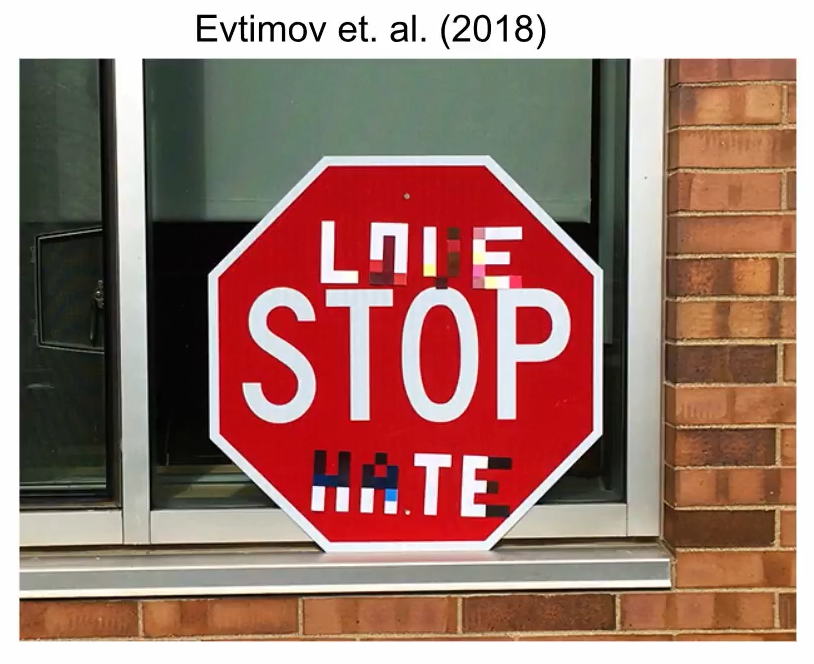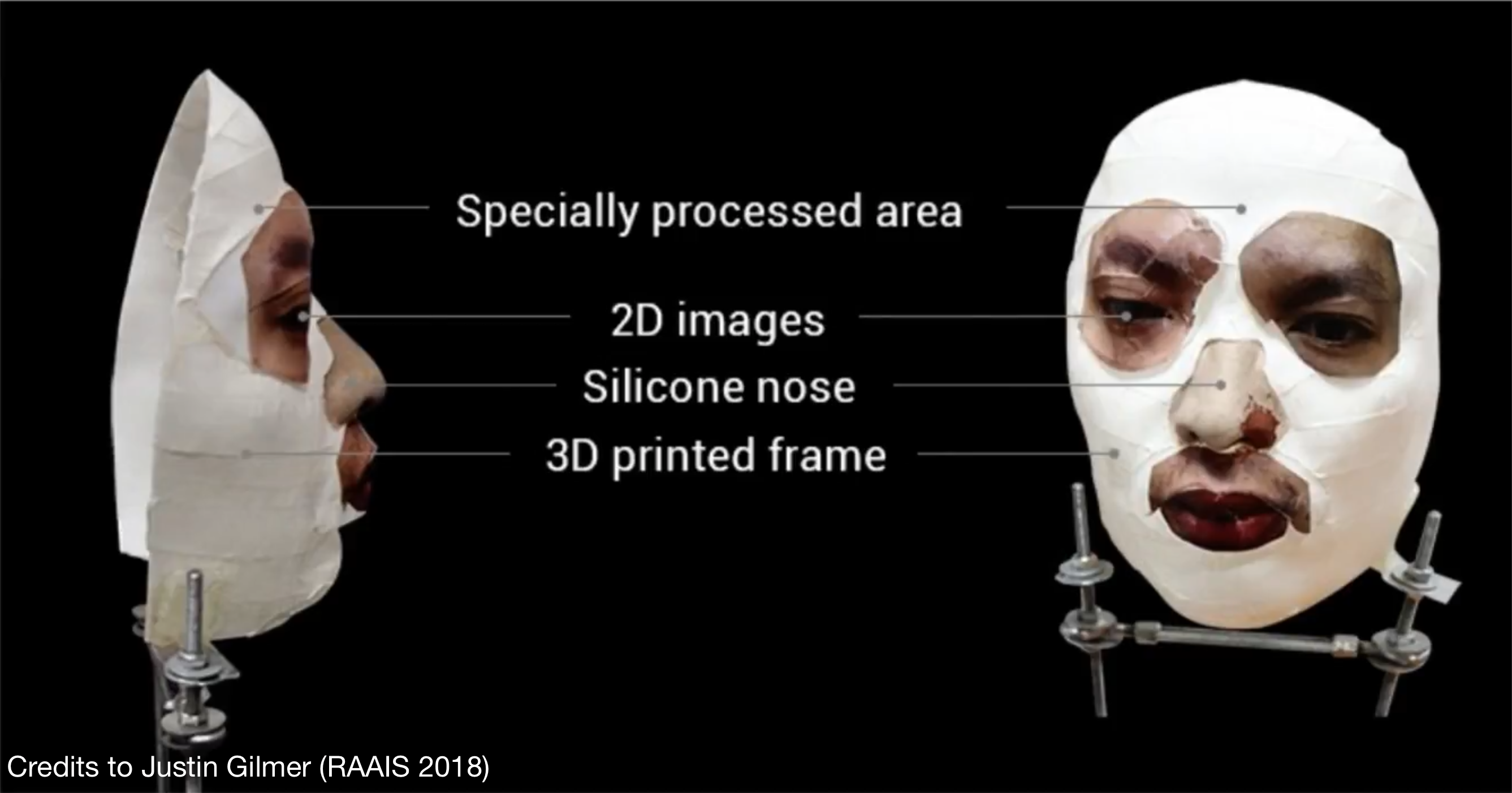Motivating the Rules of the Game for Adversarial Example Research
Justin Gilmer, Ryan P. Adams, Ian Goodfellow, David Andersen, George E. Dahl (July 2018)
Presented by Christabella Irwanto
Goals of the paper
- Taking a step back and evaluating the relevance of adversarial ML in the real world
- Adversarial example defense papers mostly consider abstract, toy games that do not relate to any specific security concern
- Lacking precise threat models important in security
Background and definitions
- “Perturbation defense” literature: motivated by security concerns and proposing defenses against unrealistically-restricted perturbations
- Adversarial example = restricted perturbation of a correct example
- Assume “perceptibility” of perturbations is a security risk
- Started by Szegedy’s “Intriguing properties of neural networks”
- Adversarial example: an input to a machine learning model intentionally designed to cause the model to make a mistake (Goodfellow et al. [1])
- The example itself could be anything
Key contributions 🔑
- Establish taxonomy of plausible adversary models
- Place recent literature within the taxonomy
- Recommend a path forward for future work
- Clearly articulate threat model
- More meaningful evaluation
Possible rules of the game
To study security, we need a threat model that is
- well defined
- clearly stated
- inspired by realistic systems
Goals of the attacker
- Targeted attack
- Induce a specific error, e.g. 🐱 ➡ 🐶
- Untargeted attack
- Induce any error, e.g. 🐱 ➡ 🐶 / 🐼 / 🦁 / 🐷 ❓
Knowledge of the attacker
- 🐵 “Whitebox”
- Full knowledge of model internals and training data
- 🙈 “Blackbox” query access
- System details are unknown but it can be queried
- ❓Partial knowledge
- Between the two extremes
Who goes first, and is the game repeated?
- Defense strategies:
- “Reactive”: defender can adapt to current attacks
- “Proactive”: defender must anticipate the all potential attack distributions
- In current literature, generally defender goes first and must be proactive
Action space of the attacker
What are they allowed to do?

Action space of the attacker
Can they do this instead?

Action space of the attacker
Can they pick their own starting point?

Action spaces
| Security setting | Constraints on input (human perception) | Starting point |
|---|---|---|
| Indistinguishable perturbation | Changes must be undetectable | Fixed |
| Content-preserving perturbation | Change must preserve content | Fixed |
| Non-suspicious input | Input must look real | Any input |
| Content-constrained input | Input must preserve content or function | Any input |
| Unconstrained | Any | Any |
Content-constrained input
- Any input \(X\) with desired content or payload
- E.g. image spam can start from anything as long as it delivers an advertisement, and evades machine detection (untargeted attack)
- Repeated game
- Other examples: malware, content trolling

Non-suspicious input
- Any \(X\) that would appear to a human to be real
- E.g. “Voice assistant attack”
- Perturb white noise/music etc. to be interpreted as a command (Carlini et al. [83])

Unconstrained input
- Any \(X\) with no constraints whatsoever
- E.g. “voice assistant” scenario variations, iPhone FaceID unlock
Content-preserving perturbation
- Perturb a particular \(X\) in a way that preserves content
- The space of content-preserving perturbations:

Content-preserving perturbation
- E.g. “pay-per-view” attack
- Perturb video to evade detection, but preserve content
- Viewers will tolerate huge perturbations
Imperceptible perturbation
- Perturb a particular \(X\) in a way that is imperceptible to a human
- E.g. ??? 404
- Imperceptibility can help with deniability, or longer evasion of detection, but it is not required
- Makes large assumptions about the attacker
- Robustness metric was not intended to be a realistic threat model, but as a toy game

Recent literature
- Most perturbation defense papers surveyed assume
- Fixed initial sample drawn from data distribution
- Sample can be perturbed with \(l_p\) norm \(< \epsilon\)
- Often unclear if defense is proactive or reactive
- Optimization problem to find worst case perturbation \(\displaystyle \delta_{adv} = \arg\max_{\substack{||\delta||_p < \epsilon}} L(x + \delta, y)\)
- Evaluation metric is “adversarial robustness”, \(\mathbb{E}_{(x, y)\sim p(x, y)} [\mathbb{1}(f(x+\delta_{adv}) \neq y)]\)
- \(f(x)\) is model’s prediction on \(x\), and \(y\) is \(x\)’s true label
- Probability that a random \(x\) is with distance \(\epsilon\) of a misclassified sample
Problems with measuring robustness
- Evaluating \(l_p\) robustness is NP-hard
- Frequent cycles of falsification


Robustness is a misleading metric
Suspicious adversarial defenses
- Hardness inversion: robustness against a more powerful attacker (e.g. whitebox/untargeted) is higher than weaker attacker (e.g. blackbox/targeted)
- Symptom of incomplete evaluation, e.g. stuck in local optimum/gradient masking
Where does it fit in the taxonomy?
- Closest fit for current literature is in indistinguishable perturbation ruleset
- Standard ruleset is weakly motivated
- Does not fit perfectly in the taxonomy of realistic rulesets
- Even if we take the spirit of the literature’s ruleset…
\(l_p \neq\) perceived similarity
- \(l_p\) is not even a good approximation for what humans see
- E.g. 1 pixel translation of image: imperceptible but huge \(l_p\) norm
- Depends on psychometric factors
- Given time to make decision? Motivated to look closely?

Plausibility of examples in literature
If security is the motivation, we should
- Study the most realistic ruleset
- Consider real-world threats
Let’s look at common motivating scenarios for the standard ruleset in the literature
Stop Sign Attack
- “Adversarial street sign” to fool self-driving cars
- Imperceptible perturbations are not strictly required
- High-effort compared to…

Knocked-over Stop Sign Attack
… simply covering sign, or knocking it over

Figure 3: “knocked over stop sign attack” is 100% successful in “tricking” the model, robust to lighting and perspective changes, and even worse, already occurs “in the wild”!
Evading Malware Detection
- Restricted \(l_0\) changes to malware binary’s feature vector
- Fits in the content-constrained input ruleset, but not in the standard ruleset
- Why would malware authors restrict themselves?
- Vast space of code alterations preserving essential functionality
Fooling Facial Recognition 👓
- Compelling only for weaker attacker action space constraints than the standard rules
- “Accessorize to a crime” (Sharif et al.) considers attacker impersonating someone to enter restricted area
- Glasses would fool face recognition system
- But… high quality prosthetic disguise would fool both human guards and face recognition system
Test Set Attack

- Litmus test: pray some random \(x\) will be misclassified, i.e. the naïve adversarial example
- Non-zero error rate on test set \(\implies\) vulnerability to test set attack \(\implies\) existence of adversarial examples
- Many existing defenses increase test error
- Variation: randomly perturbing an image, also effective in inducing errors [107]
Evaluating errors realistically
- Researchers should attempt to approximate actual deployment conditions
- E.g. How prevalent is the adversary’s presence?
- Balancing accuracy on IID test set vs. on adversarial examples

- Prop = 0 is unrealistically optimistic; 1 is pessimistic
- To justify ALP, attackers need to be present > 7.1% of the time
- M-PGD model is never preferred
Moving forward
- Standard game rules not motivated by concrete security scenarios
- Solutions to \(l_p\) problem e.g. Madry defense: optimize metric directly
- Goodhart’s Law: When a measure becomes a target, it ceases to be a good measure
- Not generalizing to other threat models
Evaluating SOTA defense realistically
- Madry defense on MNIST unbroken within \(l_\infty\) rules
- Suppose defense is for revenge porn attack (get photos of specific person past ML detector); MNIST as proxy
- “Modify background pixels” attack
- “Lines” attack; required 6 (median) queries to find an error
- Defense only designed against small perturbations in \(l_1\) and not other metrics, let alone content preservation

Don’t forget simpler attacks
- Explore robustness to whitebox adversary in untargeted content preservation setting
- But also robustness to high-likelihood, simplistic blackbox attacks (e.g. test set attack, simple transformations)
- Content preserving image transformations remains largely unexplored in the literature
- Transformations considered in Engstrom et al. [107] and Verma et al. [122] are a good start
Security-centric proxy metrics
- Difficult to formalize “indistinguishable”/“content-preserving”/“non-suspicious”
- \(l_p\) metric as a proxy for “indistinguishability” is not grounded in human perception
- Current best proxies for image content similarity rely on deep neural networks (Zhang et al. [123]) - - Cannot measure itself!
- Short-term approach: hold-out distributions of “content-preserving” transformations
- Generalization out of distribution is more reliable evaluation than performance on restricted worst-case attacks (NP-hard evaluation)
- Content-constrained and non-suspicious: seem very domain-specific
- Best to address specific, concrete threats before trying to generalize
- E.g. Defend “voice assistant” attack with user design: notify user for all commands
Conclusion
- 1. Broaden definition of adversarial examples
- Take extra care to build on prior work on ML security
- Think like an attacker, realistic game rules
- Consider real systems and attacks that exist in the wild
- Develop new abstractions that capture realistic threat model
- 2. Recenter small perturbation defenses as machine learning contributions instead of security
- Errors are still errors worth removing if possible, regardless of source.
- Better articulate motivations for study
Discussion
- What are the ML-centric motivations for studying \(l_p\) perturbations shown by Szegedy?
- Works on adversarial examples not motivated by security [81, 93, 106, 109–114]
- “Explaining and Harnessing Adversarial Examples”: Alternate way of evaluating model on some out-of-sample points, with norm ball metric: idea that changes smaller than some specific norm should never change the class [93]
- ‘No free lunch’: adversarial training induces more semantically meaningful gradients and gives adversarial examples with GAN-like trajectories
Discussion
- Directions on building robustness to content-preserving transformations?
- “Manifold Mixup: Encouraging Meaningful On-Manifold Interpolation as a Regularizer”
- “A Rotation and a Translation Suffice: Fooling CNNs with Simple Transformations”

